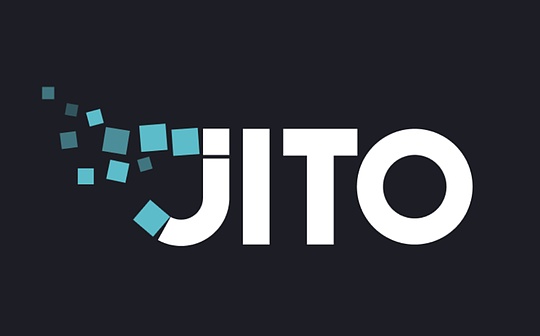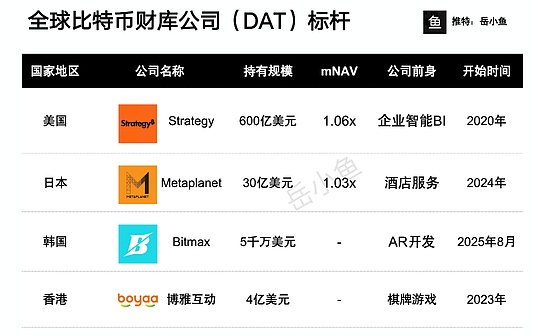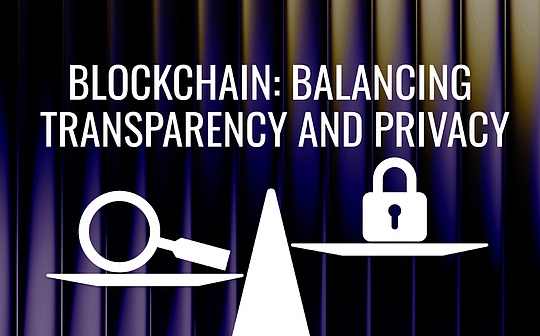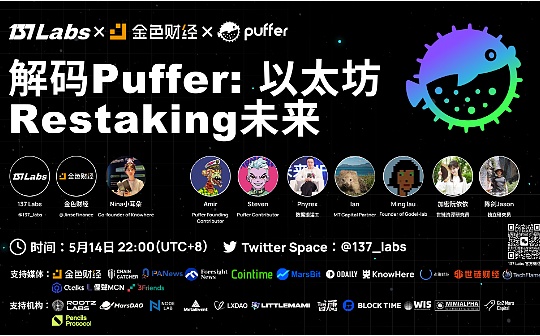
Source: 137Labs
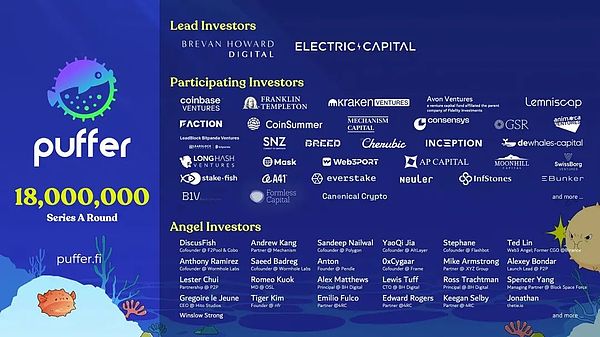
Puffer is the first native Liquid Restake Protocol (nLRP) built on EigenLayer.It introduces native Liquid re-staken tokens (nLRT) that can accumulate PoS re-staken rewards.Nodes within the protocol use Puffer’s penalty resistance technology to reduce risks and improve capital efficiency, while increasing rewards through native restakes.
As one of the hottest tracks in 2024, the concept of “re-staking” was proposed by Sreeram Kannan, founder of Eigenlayer. Its core mechanism is to allow stakers to pledge the already pledged ETH (including various LSTs) in other agreements againWith and participate in its verification process on DApp, third-party projects can enjoy the security of the ETH main network, and ETH stakeholders can also get more benefits, achieving a win-win situation.
Puffer has received investments from top institutions in the circle such as Jump, Coinbase, Binance, ETF publishers Fidelity and Franklin. Its main network was launched on May 8. Today we are honored to invite Puffer Founder and the team to share with us.Puffer’s advanced concepts, technologies and future development directions in Restaking.
PART 1 |PUFFER VIEW
1. As a popular project in the Restaking track, Puffer has pledged more than 455K ETH and TVL has nearly 1.4B, and has been favored and invested by many crypto institutions and individuals including Binance, Shenyu, Fidelity, Coinbase, etc. The reason why Puffer has achieved such a success iswhere?
Puffer Founding Contributor Amir:Puffer’s goal is to create a top-level infrastructure layer on Ethereum.Our goal is to create a secure platform for stakers and node operators to participate in stake and restake in the future.Our unique architecture combines hardware-based security with economic guarantees from Ethereum node operators, providing users with a lower risk and lower entry barrier.
Unlike other platforms, any user can join Puffer as an operator or stakeholder.For blockchain platforms, security lies in decentralization.This is why we attracted such high total lock-in value before the mainnet was launched, and why our vision has won the support of many industry giants.
2. How can Puffer achieve a minimum of only 1 ETH to become a mainnet node operator, thereby reducing the hard threshold of 32ETH to expand the range of Ethereum participants?How can Puffer balance improving the centralization of ETH staking, ensuring asset security, and improving yields?
Puffer Founding Contributor Amir:Making node operations license-free and reducing margin is not easy.A powerful mechanism must be created to ensure that the stakeholder’s funds are secure when the node operator has only 1 ETH margin.At Puffer, we have to solve three challenges:
Lazy Nodes: Traditionally, centralized staking providers criticize the concept of decentralized pools because of the problem of lazy node operators.A lazy node can switch at will within the allowed margin range (1 ETH) and reject the user’s reward.Puffer solves this issue with a validator ticket.
MEV Theft: One of the biggest challenges in reducing margin for node operators is that they may steal MEV (if a node gets a higher MEV block than its margin, they will steal it).Puffer once again solves this problem with the concept of a validator ticket.
Punishment mechanism: This is a risk to user funds on any protocol.Not only that, Puffer also implements financial guarantees (1/2 ETH), and we also provide our own hardware-based counter-punishment tools to protect users.Our 1 ETH Counter-Punishment Margin Program is available next month.
Lower margin means that node operators can run more nodes, thus having a higher chance of proposing blocks and receiving higher rewards.
In addition, re-staking can help users get more rewards than simple pledges.
3. What impact will the Puffe main network be launched on the Restaking track?As the main network upgrades Puffer’s security signature, anti-fraud resistance and Native Liquid Restaking are there any new changes?
Puffer Founding Contributor Amir:The Puffer mainnet marks the launch of the native mobile re-staking function on Puffer.The stETH stored in the Puffer will be converted to ETH to further realize the decentralization of the Ethereum network.With the launch of native restake, stakers can now take advantage of AVS rewards.Counter-punishment and security key management features reduce users’ risks in staking and restaking.Currently, there is no penalty mechanism on AVS, but once it goes online, this will become very important.Puffer plans to launch its own AVS, providing higher rewards to its stakers and node operators through staking.
4. What is the launch time of Puffer Token?What are the ways to obtain quotas other than pledge?What is the mutual empowerment between the Puffer project and the Token?
Puffer Founding Contributor Amir:Every decentralized project requires tokens.We cannot announce the specific timetable at this time, but there will be news soon.At Puffer, tokens will play an important role in deciding which AVS and which staked operators to be introduced.We are also considering introducing the vetoken model.
5. Will Puffer be deployed in multiple chains in the future?What will the next Roadmap look like?
Puffer Founding Contributor Amir:Not only will Puffer plan to launch its unique L2 solution, it will soon expand native pufETH minting to other chains to reduce stakeholders’ gas fees.We also plan to build an architecture that enables node operators to join smoothly with lower gas fees and simpler reward redemption.More information will be released soon.
PART 2|KOLs VIEW
1. From Staking to Restaking, what impact does the re-staking track have on the ETH ecosystem?
Independent Researcher Jason:First, from a macro perspective, the main impact of re-staking is to enhance Ethereum’s security.Currently, Ethereum has more than 10,300 nodes, making it the safest blockchain second only to Bitcoin.Through restaking, especially through decentralized verification services (AVS), Ethereum’s security can be released to other layer two networks (Layer2), oracles, cross-chain bridges, etc.This means that Ethereum is not only a standalone global computer, but also becomes the security basis for many other ecological projects, thus enhancing its overall robustness.
Although Ethereum’s narrative appeal seems to have weakened in the current cycle, re-staking is undoubtedly the most important new track in this bull market.With projects like Renzo and specific TGE completed, many people are worried about whether the restaking track has reached the end, but the reality is that this is just the beginning.At present, the entire re-pled track may have just started the top 20%, and many projects will be launched in the main network in the future.
The establishment and sustainability of the re-pled track still needs to be verified by time.Some people question whether restaking is just a point game, but through staking and security release, Ethereum may achieve real prosperity through these accumulations in the future.Therefore, it is wrong to think that Ethereum’s restaking track has reached its final goal, and this field has just begun.
Senior investment researcher Elma:Since Ethereum transformed from Proof of Work (PoW) to Proof of Stake (PoS) in 2022, more and more people have begun to pay attention to its staking method, and its staking rate has also increased significantly.At present, many Ethereum are pledged in centralized exchanges, large swap platforms or some leading liquidity staking (LSD) protocols.Judging from the data, the pledge ratio of Ethereum has far exceeded the initial launch threshold of 15%.This has led to a certain monopoly tendency in the market.In addition, due to certain technical and economic thresholds for staking, for example, it is necessary to have 32 Ethereum, and verification nodes in the network are becoming increasingly concentrated.
Judging from the pledge narrative, it initially brought liquidity and benefits to self-deposited assets through the LSD protocol, and then developed into LSD and LSD 5, becoming a strong consensus interest-generating asset.Restaking provides a new staking method that helps the rapid development of the Ethereum ecosystem and reduces centralized trends and risks.
From a financial perspective, from staking to restating has become a very cost-effective investment choice.Participating in re-polization can basically obtain multiple benefits.Similar practices are also very common in traditional finance.Re-pled not only attracts people from the traditional financial field to enter the cryptocurrency field, but also enhances people’s recognition of the financial attributes of Ethereum.Through re-staking, Ethereum can expand its business peripherals and build a more structured financial system to further improve its self-narrative capabilities.
Data porter Phyrex:They (re-staking) are actually a continuation of the ecosystem, especially re-staking.I don’t think restaking is a whole new track, it may actually be just an extension of Decentralized Finance (DeFi).DeFi itself has an impact on the traditional economy, so whether it is staking or re-staking, they are a further expansion of DeFi.
Ethereum has relatively low on-chain returns in the past.Through pledge and re-staking, this not only helps Ethereum itself, but also promotes the on-chain development of the Ethereum ecosystem.Many people believe that pledge and re-pled slow down liquidity on the Ethereum chain, thereby reducing selling pressure.For friends who trade frequently, more liquidity locked down may have a positive impact on prices.
In summary, while enhancing Ethereum’s security and stability, pledge and re-staking have also promoted the development of the entire ecosystem and provided potential support for prices.This not only enhances user trust, but also creates more opportunities for Ethereum’s application in the DeFi field.
2. What is the current situation of the EigenLayer ecosystem?What will be the future development of the re-pled track be like?
Regarding the future development form, from the perspective of the primary market, EigenLayer is a very important ecological project, and Puffer has also been invested by the Agenda team.This makes me very optimistic about Puffer.I think there will definitely be a leading project in the AVS ecosystem, just like the projects with very high returns and great influence in the Polkadot ecosystem.
In general, there will be many projects emerging in the AVS ecosystem, but one or several leading projects are likely to stand out and become the core and leader of the entire ecosystem.I am confident in the future development of Puffer and EigenLayer and look forward to seeing them play a bigger role in the ecosystem.
3. How do you view Restaking is a nesting doll game that passes flowers through the drums. TVl repeated calculations and false prosperity. If a project has problems, it may lead to a series of stampedes?
Independent Researcher Jason:There is a certain overheating phenomenon in the Restaking track, which leads to a mixture of projects, such as “mastiff dolls” and repeated calculation of TVL, which need to be treated with caution.
The actual benefits you can get through restaking are not the so-called “eat more with one fish” points game, but the benefits of pledging Ethereum itself, coupled with the benefits of capturing the security of other chains and protocols through restaking.
Participating in projects endorsed by strong VCs and becoming nodes or contributors of the project is a relatively safe way to participate in the primary market and you can share your profits with the bigwigs.
Try to avoid participating in pheasant agreements, and even if they may give exaggerated benefits, make sure your efforts are rewarded and the cost of investment is safe.
Emphasize the careful selection of projects, especially in the hot market, and beware of the risks of bad projects and choose projects with reliable endorsement and strict background checks to participate.
4. How can retail investors or novices identify participating in high-quality Restaking projects?
The risks are mainly divided into two aspects: one is to once again explore the possible arbitrage risks of other related or non-core agreements after participating in high-quality LRT projects; the other is that some projects may be abused due to market overheating, and there are problems of opacity and centralization..
Methods to identify high-quality Restaking projects include focusing on primary market information such as team background and fund endorsement.In addition, TVL is also an important indicator for evaluating the attractiveness of projects, especially for asset management projects such as Ethereum.
Ethereum’s status as a crypto treasury bond, its TVL reflects the degree of participation of institutions and asset management, so projects with high TVL often have support from large institutions.For retail investors, participating in projects requires careful selection and attention to indicators such as TVL.
Senior investment researcher Elma:In addition to financing and TVL, the incentive policies and technical aspects of the project are also important considerations.Especially for Restaking projects, technical security is crucial.
Restaking is not a simple game of playing drums and passing flowers, but creates a leverage opportunity for investors.But high returns are often accompanied by high risks, so safety issues are crucial.
When choosing a project, pay attention to its technical level.For example, the Puffer project has performed outstandingly in terms of technical security. Its security center is supported by the Ethereum Foundation and can effectively reduce technical risks and punish risks and provide financial guarantees.Reducing technical risks is one of the important angles for choosing high-quality projects.
Organizer:137Labs | Puffer | Jinse Finance
host:Little Ear Nina

